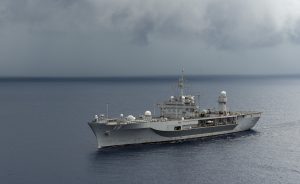The USS Blue Ridge, the flagship of the U.S. Seventh Fleet, is paying a visit this week to Vietnam’s Cam Ranh Bay, the latest sign of the improved relations between the two nations.
As VnExpress reported, the Blue Ridge arrived at around 1 p.m. on Monday, “carrying over 1,000 officers and personnel.” The ship was also accompanied by the U.S. Coast Guard cutter Waesche.
During the five-day visit, VnExpress reported, “U.S. naval personnel will meet officials from the Khanh Hoa People’s Committee, as well as members of the local navy. They will engage in athletic exchanges with the Vietnamese navy and coast guards, and they will also take part in discussions with the units under Vietnam’s Ministry of National Defense.”
The visit follows the establishment of a Comprehensive Strategic Partnership between Vietnam and the United States in September of last year, which placed a capstone on two decades of steadily improving relations. The upgrade is likely to see increased port calls and visits by the U.S. Navy, which have increased at a steady clip over the past decade.
In June of last year, the aircraft carrier USS Ronald Reagan paid a port call to Da Nang, close to Cam Ranh Bay in central Vietnam. This followed the visits of the carriers USS Theodore Roosevelt (in 2020) and USS Carl Vinson (in 2018).
However, Hanoi is more choosy about which foreign vessels it allows to visit Cam Ranh Bay, often described as one of the finest deep-water harbors in Asia. After serving as a U.S. naval base (prior to 1972) and a Soviet base (prior to 2002), the port now serves as home to its fleet of Russian-built Kilo-class submarines.
In 2010, Vietnam declared its plans to modernize and refurbish the port at Cam Ranh Bay and opened it to foreign vessels. Now known officially as Cam Ranh International Port (CRIP), the base has hosted visits by ships from Japan, China, Russia, Australia, and France – a reflection in microcosm of Vietnam’s omnidirectional foreign policy.
U.S. vessels have only visited the CRIP on a handful of occasions. In October 2016, the guided-missile destroyer USS John S. McCain visited the base along with the submarine tender USS Frank Cable, becoming the first U.S. Navy warships to do so since the end of the Vietnam War. The John S. McCain and USS Coronado, an Independence-class Littoral Combat Ship, visited the following year.
As in so many other aspects of U.S.-Vietnam relations, the return of U.S. Navy vessels to Cam Ranh Bay is layered with historical inversions and ironies. For instance, the John S. McCain bore the name of the U.S. pilot (and later senator and presidential candidate) who was shot down over north Vietnam in 1967 and imprisoned for five-and-a-half years.
A similar backstory attends the Blue Ridge, the oldest operational ship in the U.S. Navy. While VnExpress noted that it has visited Vietnam twice in the past, in 2009 and 2012, it is no stranger to Vietnamese waters. In mid-1972, two years after its commissioning Blue Ridge took part in the U.S. response to North Vietnam’s Easter Offensive, the last major U.S. amphibious combat engagement of the Vietnam War. During the campaign, South Vietnam’s President Nguyen Van Thieu came aboard the ship to thank the ship’s crew for their aid in “the preservation of Peace and Freedom” in South Vietnam.
Later, it took part in Operation Homecoming, the return of U.S. prisoners of war from Vietnam, and the evacuation of U.S. and South Vietnamese personnel during the fall of Saigon in April 1975.

































